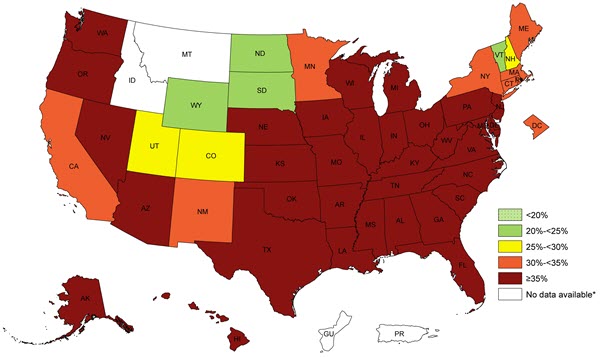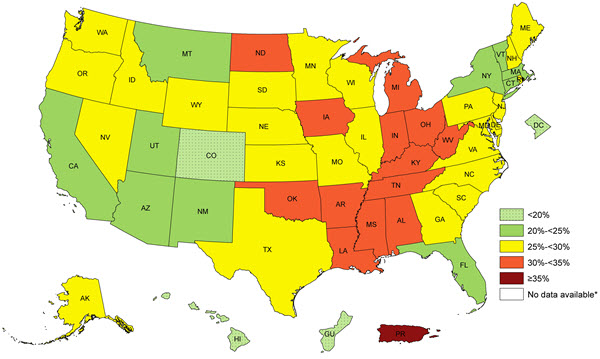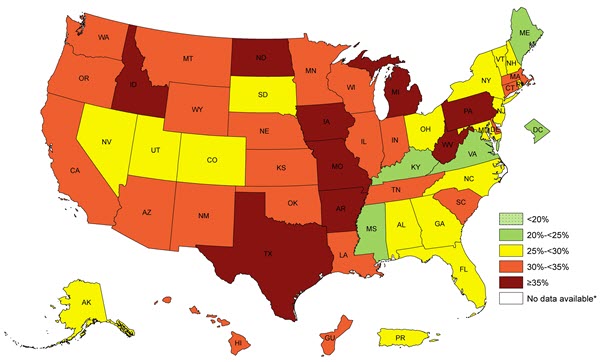The U.S. Centers for Disease Control and Prevention has released data from its Behavioral Risk Factor Surveillance System that reveals massive disparities in obesity rates among the nation’s different major ethnic groups.
The BRFSS data show that while obesity rates among African Americans are least 35 percent in 33 states, only one state has an obesity rate of 35 percent or greater among white Americans.
For purposes of the data, the standard obesity definition of having a Body Mass Index (BMI) of 30 or higher is applied. Body Mass Index is a measure of an adult’s weight in relation to his or her height, calculated by using the subject’s weight in kilograms divided by the square of his or her height in meters. The NIH has a handy interactive BMI index calculator that interprets the metric height and weight criteria in U.S./Imperial measure.
Commenting to NPR’s Jane Greenhalgh Dr. Donald Lloyd-Jones, Professor and chair of the department of preventive medicine at the Northwestern University Feinberg School of Medicine refers to the obesity phenomena documented in the BRFSS statistics as “the largest epidemic of a chronic disease that we’ve ever seen in human history,”
Dr. Lloyd-Jones’s research interests lie in cardiovascular disease epidemiology, risk estimation, and prevention. A main focus of his research has been investigation of the lifetime risks for various cardiovascular diseases, and factors which modify those risks. Other areas of interest include CVD risk estimation using novel biomarkers, imaging of subclinical atherosclerosis, and the epidemiology of hypertension.
Dr. Lloyd-Jones was principal investigator in a major study entitled “Lifetime Risks of Cardiovascular Disease” published in the New England Journal of Medicine in January 2012, which analyzed data from 18 population-based studies, involving over 250,000 people, and measured lifetime risks of cardiovascular disease across the age spectrum in black adults and white adults.
Combining BRFSS data from 2012 through 2014, the report, “Prevalence of Self Reported Obesity Among U.S. Adults by Race/Ethnicity, State and Territory, BRFSS, 2012-2014” found that non-Hispanic blacks had the highest prevalence of self-reported obesity (38.1%), followed by Hispanics (31.3%) and non-Hispanic whites (27.1%). Three years of data were combined to ensure sufficient sample size. Excluded from the survey data were persons with
• Height: <3 feet or e”8 feet
• Weight: <50 pounds or e”650 pounds
• BMI: <12 kg/m2 or e”100 kg/m2
• Pregnant women
In the Prevalence of Self-Reported Obesity Among Non-Hispanic White Adults by State and Territory, BRFSS, 2012-2014 survey, data show that two states (Colorado and Hawaii), the District of Columbia, and Guam had a prevalence of obesity less than 20%, while 10 states had a prevalence of obesity between 20% and <25%, 25 states had a prevalence of obesity between 25% and <30%, and 13 states had a prevalence of obesity between 30% and <35%. Puerto Rico had a prevalence of obesity of 35% or greater. Higher prevalence of white adults with obesity was found in the Midwest (29.3%) and the South (27.9%), followed by the Northeast (25.9%), and the West (23.9%).
The Prevalence of Self-Reported Obesity Among Non-Hispanic Black Adults by State and Territory, BRFSS, 2012-2014 graphic shows that no state had a prevalence of obesity among African Americans of less than 20%, and just four states had a prevalence of obesity between 20% and <25%. Three states had a prevalence of obesity between 25% and <30%, eight states and the District of Columbia had a prevalence of obesity between 30% and <35%, and a whopping 33 states had a prevalence of obesity among black Americans of 35% or greater. Higher prevalence of black adults with obesity were found in the South (39.5%) and the Midwest (38.8%), followed by the West (34.6%), and the Northeast (34.2%).
The Prevalence of Self-Reported Obesity Among Hispanic Adults by State and Territory, BRFSS, 2012-2014 graphic reveals that no state had a prevalence of obesity among hispanic Americans of less than 20%, while four states and the District of Columbia had a prevalence of obesity between 20% and <25%. Sixteen states and Puerto Rico had a prevalence of obesity among hispanics of between 25% and <30%, 21 states and Guam had a prevalence of obesity between 30% and <35%, and nine states had a prevalence of obesity of 35% or greater. Higher prevalence of hispanic adults with obesity were found in the Midwest (33.0%) and the South (31.5%), followed by the West (31.2%), and the Northeast (30.2%).
The BRFSS is the nation’s premier system of health-related telephone surveys that collect state data about U.S. residents regarding their health-related risk behaviors, chronic health conditions, and use of preventive services. Established in 1984 with 15 states, BRFSS now collects data in all 50 states as well as the District of Columbia and three U.S. territories. BRFSS completes more than 400,000 adult interviews each year, making it the largest continuously conducted health survey system in the world.
Sources:
U.S. Centers for Disease Control and Prevention
CDC Behavioral Risk Factor Surveillance System
Image Credits:
U.S. Centers for Disease Control and Prevention
CDC Behavioral Risk Factor Surveillance System
Northwestern University Feinberg School of Medicine




